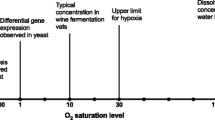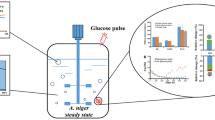Abstract
A combination of chemostat cultivation and a defined medium was used to demonstrate that uracil limitation leads to a drastic alteration in the physiology of auxotrophic cells of Saccharomyces cerevisiae. Under this condition, the carbon source is dissimilated mainly to ethanol and acetate, even in fully aerobic cultures grown at 0.1 h−1, which is far below the critical dilution rate. Differently from nitrogen-, sulphur-, or phosphate-limited cultures, uracil limitation leads to residual sugar (either glucose or sucrose) concentrations below 2 mM, which characterizes a situation of double-limitation: by the carbon source and by uracil. Furthermore, the specific rates of CO2 production and O2 consumption are increased when compared to the corresponding prototrophic strain. We conclude that when auxotrophic strains are to be used for quantitative physiological studies, special attention must be paid to the cultivation conditions, mainly regarding medium formulation, in order to avoid limitation of growth by the auxotrophic nutrient.
Similar content being viewed by others
References
Abbott DA, Knijnenburg TA, de Poorter LMI, Reinders MJT, Pronk JT, van Maris AJA (2007) Generic and specific transcriptional responses to different weak organic acids in anaerobic chemostat cultures of Saccharomyces cerevisiae. FEMS Yeast Res 7:819–833
Barford JP, Johnston JH, Mwesigye PK (1995) Continuous-culture study of transient behaviour of Saccharomyces cerevisiae growing on sucrose and fructose. J Ferment Bioeng 79:158–162
Boer VM, de Winde JH, Pronk JT, Piper MD (2003) The genome-wide transcriptional responses of Saccharomyces cerevisiae grown on glucose in aerobic chemostat cultures limited for carbon, nitrogen, phosphorus, or sulfur. J Biol Chem 278:3265–3274
Boer VM, Amini S, Botstein D (2008) Influence of genotype and nutrition on survival and metabolism of starving yeast. Proc Natl Acad Sci USA 105:6930–6935
Brauer MJ, Huttenhower C, Airoldi EM, Rosenstein R, Matese JC, Gresham D, Boer VM, Troyanskaya OG, Botstein D (2008) Coordination of growth rate, cell cycle, stress response, and metabolic activity in yeast. Mol Biol Cell 19:352–367
Çakar ZP, Sauer U, Bailey JE (1999) Metabolic engineering of yeast: the perils of auxotrophic hosts. Biotechnol Lett 21:611–616
Diderich JA, Schepper M, Van Hoek P, Luttik MA, Van Dijken JP, Pronk JT, Klaassen P, Boelens HF, Teixeira-de-Mattos J, Van Dam K, Kruckeberg AL (1999) Glucose uptake kinetics and transcription of HXT genes in chemostat cultures of Saccharomyces cerevisiae. J Biol Chem 274:15350–15359
Frick O, Wittmann C (2005) Characterization of the metabolic shift between oxidative and fermentative growth in Saccharomyces cerevisiae by comparative C-13 flux analysis. Microb Cell Fact 4:16
Mashego MR, van Gulik WM, Vinke JL, Heijnen JJ (2003) Critical evaluation of sampling techniques for residual glucose determination in carbon-limited chemostat culture of Saccharomyces cerevisiae. Biotechnol Bioeng 83:395–399
Olsson L, Nielsen J (1997) On-line and in situ monitoring of biomass in submerged cultivations. TIBTECH 15:517–522
Pantazopoulou A, Diallinas G (2007) Fungal nucleobase transporters. FEMS Microbiol Rev 31:657–675
Postma E, Verduyn C, Scheffers WA, Van Dijken JP (1989) Enzymic analysis of the Crabtree effect in glucose-limited chemostat cultures of Saccharomyces cerevisiae. Appl Environ Microbiol 55:468–477
Pronk JT (2002) Auxotrophic yeast strains in fundamental and applied research. Appl Environ Microbiol 68:2095–2100
Rose M, Winston F (1984) Identification of a Ty insertion within the coding sequence of the S. cerevisiae URA3 gese. Mol Gen Genet 193:557–560
Sherman F (1991) Getting started with yeast. Meth Enzymol 194:3–21
Verduyn C, Postma E, Scheffers WA, Van Dijken JP (1992) Effect of benzoic acid on metabolic fluxes in yeasts—a continuous-culture study on the regulation of respiration and alcoholic fermentation. Yeast 8:501–517
Acknowledgments
We would like to thank Luiz C. Basso (University of Sao Paulo, Brazil) for providing equipment for sugar analysis. This work was financed by grants from Fundação de Amparo à Pesquisa do Estado de São Paulo (FAPESP, São Paulo, Brazil), within the BIOEN framework, and Conselho Nacional de Desenvolvimento Científico e Tecnológico (CNPq, Brasília, Brazil). Ph.D. grants were given to T.O.B and M.G.D. by Coordenação de Aperfeiçoamento de Pessoal de Nível Superior (CAPES, Brasília, Brazil).
Author information
Authors and Affiliations
Corresponding author
Rights and permissions
About this article
Cite this article
Basso, T.O., Dario, M.G., Tonso, A. et al. Insufficient uracil supply in fully aerobic chemostat cultures of Saccharomyces cerevisiae leads to respiro-fermentative metabolism and double nutrient-limitation. Biotechnol Lett 32, 973–977 (2010). https://doi.org/10.1007/s10529-010-0248-2
Received:
Accepted:
Published:
Issue Date:
DOI: https://doi.org/10.1007/s10529-010-0248-2




